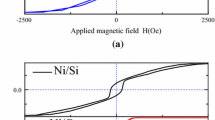Summary
The crystalline properties of 1 μm Cu films deposited on mica were found to depend on the post-annealing temperature of the substrate. At 50°C [111] texture and polycrystalline films were obtained. Up to 300°C there was neither preferred orientation nor any change of texture. The [111]-oriented particles were thicker than the [100] particles and the growth of particles with increase of temperature was about 1.2 Å/°C and 0.4Å/°C for [111]- and [100]-oriented particles respectively. Ribbon fault widths varied from 120 Å to 520 Å on increase of temperature. Dislocation densities diminished from 48·1010/cm2 to 6.4·1010/cm2 and 61·1010/cm2 to 16·1010/cm2 for [111] and [200] planes respectively. Muscovite mica was found inferior to glass as a substrate for Cu films. The large values of stacking-fault widths suggest that there is presumably no equilibrium and the faults extend right across the coherent domain. It is proposed that dislocation on the surface and those at the interface anneal out at 200°C and 250°C respectively until these are pinned when further annealing is stopped.
Riassunto
Si è trovato che le proprietà cristalline delle pelliccole di Cu da 1 μm depositate su mica dipendono dalla temperatura dello stato successivo alla tempra del supporto. A 50°C si sono ottenute strutture cristalline [111] e pellicole policristalline. Fino a 300°C non c'è stata né orientazione preferita, né alcun cambiamento di struttura. Le particelle orientate [111] si sono presentate più spesse di quelle orientate [100] e l'accrescimento delle particelle con l'aumentare della temperatura è stato circa 1.2 Å/°C e 0.4 Å/°C rispettivamente per particelle orientate [111] e [100]. L'ampiezza dei difetti a nastro ha oscillato fra 120 Å e 520 Å all'aumentare della temperatura. La densità delle dislocazioni è diminuita da 48·1010cm−2 a 6.4·1010 cm−2 e da 61·1010 cm−2 a 16·1010 cm−2, rispettivamente, per i piani [111] e [200]. Si è trovato che la mica moscovite ha doto inferiori al vetro come supporto per pellicole di Cu. I valori elevati relativi alle ampiezze dei difetti di impilamento fanno pensare che verosimilmente non c'è equilibrio ed i difetti si estendono direttamente nel dominio coerente. Si propone l'ipotesi che le dislocazioni alla superficie e quelle nell'interfaccia si temprino a 200°C e 250°C, rispettivamente, finché si riuniscono quando si blocca l'ulteriore tempra.
Резюме
Обнаружено, что кристаллические свойства 1 μm медных пленок, осажденных на слюде, зависят от температуры подложки после отжига. При температуре 50°C получаются [111] текстура и поликристаллические пленки. Вплоть до температуры 300°C не было обнаружено ни преимущественнои ориентации, ни какого-либо изменения текстуры. [111] ориентированные частицы оказываются толще, чем [100] частицы и рост частиц с увеличением температуры составляет соответственно 1.2 Å/°C и 0.4 Å/°C для [111] и [100] ориентированных частиц. Ширины полос дефектов изменяются от 120 Å до 520 Å при увеличении температуры. Плотность дислокаций уменьшается от 48·1010/cm2 до 6.4·1010/cm2 и от 61·1010/cm2 до 16·1010/cm2 соответственно для плоскостей [111] и [200]. Большие значения ширин дефектов предполагают, что равновесие, по-видимому, отсутствует и дефекты распространяются прямо через когерентную область. Предполагается, что дислокация на поверхности и дислокации на границе отжигаются соответственно при 200°C и 250°C, пока дислокации не защемляются, когда дальнейший отжиг прекращается.
Similar content being viewed by others
References
K. R. Dixit:Phil. Mag.,16, 1049 (1933).
D. Walton:Phil. Mag.,7, 1671 (1962).
H. Reiss:Journ. Appl. Phys.,39, 5045 (1968).
R. L. Sehalla, N. W. Triondswell andF. D. Coffin:Single Crystal Films, edited byM. R. Franscombe andP. Sata (London, 1964), p. 301.
C. Sella andJ. J. Trillat:Single Crystal Films, edited byM. R. Franscombe andP. Sata (London, 1964), p. 201.
B. W. Sloope andC. O. Tiller:Journ. Appl. Phys.,32, 1331 (1961).
P. M. de Wolff:Acta Cryst.,13, 837 (1960).
M. S. Paterson:Journ. Appl. Phys.,23, 805 (1952).
D. Mikkola andJ. B. Cohen:Journ. Appl. Phys.,33, 892 (1962).
R. E. Smallman andK. H. Westmacott:Phil. Mag.,11, 669 (1957).
R. W. Vook, F. R. L. Schoeing andF. Witt:Single Crystal Films, edited byM. R. Franscombe andP. Sata (London, 1964), p. 69.
W. A. Jesser:Journ. Appl. Phys.,41, 39 (1970).
H. Klug andL. Alexander:X-Ray Diffraction Procedures (New York, N. Y., 1954), p. 503.
B. E. Warren:Journ. Appl. Phys.,32, 2428 (1961).
A. P. Rowe andL. O. Brockway:Journ. Appl. Phys.,37, 2703 (1966).
A. Yelon andR. W. Hoffman:Journ. Appl. Phys.,31, 1672 (1960).
H. D. Keith:Proc. Phys. Soc., B69, 180 (1956).
A. H. Cottrell:Dislocations and Plastic Flow in Crystals (Oxford, 1965), p. 74.
Author information
Authors and Affiliations
Additional information
Traduzione a cura della Redazione.
Переведено редакцией.
Rights and permissions
About this article
Cite this article
Mannan, K.M., Chakravarty, B. Structural parameters of Cu films. Nuov Cim B 26, 148–156 (1975). https://doi.org/10.1007/BF02755543
Received:
Revised:
Published:
Issue Date:
DOI: https://doi.org/10.1007/BF02755543




